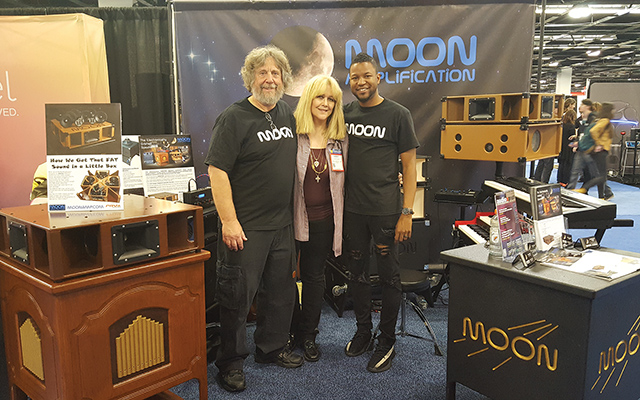The one thing all the speaker companies at NAMM have in common is an appreciation of high-quality sound, because many of the companies are passion projects for audiophiles and experienced sound engineers who are looking to solve a problem they’ve run into in their own music-making endeavors.
That’s certainly true for recent speaker startup Moon Amplification. Roy Davis, an audio engineer with a knack for developing revolutionary solutions, started the company. During his time with Qualcomm in the ’90s, Davis’ team devised a touchscreen dataphone that ran on a general-purpose operating system, well before the iPhone hit the market. He started Moon Amplification to solve a problem he encountered after he got back into playing the keyboard. “I played keyboards back in high school and college,” Davis began, “and, a couple of years ago, I bought myself a nice keyboard and started playing again. But I realized that the Leslie emulation on the keyboard didn’t sound great through stereo speakers.”
Davis was inspired by an idea that his wife and the President of Moon Amplification, Nancy Moon, had. “I worked really hard trying to make stereo speakers sound good with an emulator,” he explained. “I was never satisfied, until Nancy came up with the idea of using a cabinet with speakers on all four sides.”
The couple also drew on Moon’s last name for the company’s branding. “People refer to this as a rotary cabinet,” Davis remarked. “And it really doesn’t rotate; it orbits. The sound has to go around in a circle, and it has to be physically separated from the center. Making the circle is an orbit…the moon orbits…so it all ties together.”
The Moon Amplification line features four unique takes on the Leslie speaker, including three bass models. “The product line is called the skamp,” Davis said. “It started as an adjunct to an SK-1 or SK-2 organ, which is what I happen to have. So, ‘SK’ plus amplifier and you get ‘skamp.’” He continued, “The skamp cabinet is a standalone unit. It does the top rotor, bottom rotor, left and right stereo. The bass cabinets are separate. We have the bassLite, which is on the smaller side. We have the bigBass, which is a little heavier and which has a lot more power. And then we have the subBass, which has pretty much the same electronics as the bigBass, but it’s more a piece of furniture that’s made to look pretty.”
To read more of NAMM New Class 2017, click here.


